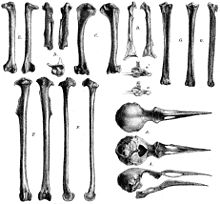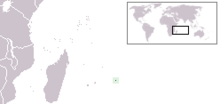| Rodrigues starling | |
|---|---|

| |
| The lectotype skull and other bones as depicted in the 1879 description | |
| Scientific classification | |
| Domain: | Eukaryota |
| Kingdom: | Animalia |
| Phylum: | Chordata |
| Class: | Aves |
| Order: | Passeriformes |
| Family: | Sturnidae |
| Genus: | †Necropsar Günther & Newton, 1879 vide Slater |
| Species: | †N. rodericanus
|
| Binomial name | |
| †Necropsar rodericanus Günther & Newton, 1879
| |

| |
| Location of Rodrigues | |
| Synonyms | |
The Rodrigues starling (Necropsar rodericanus) is an extinct species of starling that was endemic to the Mascarene island of Rodrigues. Its closest relatives were the Mauritius starling and the hoopoe starling from nearby islands; all three are extinct and appear to be of Southeast Asian origin. The bird was only reported by French sailor Julien Tafforet, who was marooned on the island from 1725 to 1726. Tafforet observed it on the offshore islet of Île Gombrani. Subfossil remains found on the mainland were described in 1879, and were suggested to belong to the bird mentioned by Tafforet. There was much confusion about the bird and its taxonomic relations throughout the 20th century.
The Rodrigues starling was 25–30 centimetres (10–12 inches) long, and had a stout beak. It was described as having a white body, partially black wings and tail, and a yellow bill and legs. Little is known about its behaviour. Its diet included eggs and dead tortoises, which it processed with its strong bill. Predation by rats introduced to the area was probably responsible for the bird's extinction some time in the 18th century. It first became extinct on mainland Rodrigues, then on Île Gombrani, its last refuge.
- ^ BirdLife International (2016). "Necropsar rodericanus". IUCN Red List of Threatened Species. 2016: e.T22710836A94263302. doi:10.2305/IUCN.UK.2016-3.RLTS.T22710836A94263302.en. Retrieved 19 November 2021.
